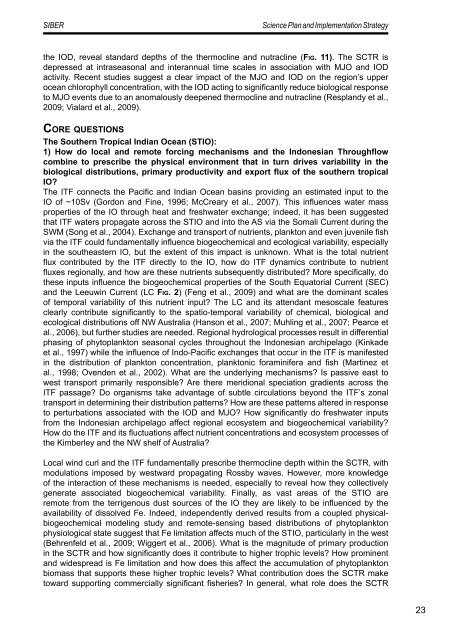SIBER SPIS sept 2011.pdf - IMBER
SIBER SPIS sept 2011.pdf - IMBER
SIBER SPIS sept 2011.pdf - IMBER
You also want an ePaper? Increase the reach of your titles
YUMPU automatically turns print PDFs into web optimized ePapers that Google loves.
<strong>SIBER</strong><br />
Science Plan and Implementation Strategy<br />
the IOD, reveal standard depths of the thermocline and nutracline (Fig. 11). The SCTR is<br />
depressed at intraseasonal and interannual time scales in association with MJO and IOD<br />
activity. Recent studies suggest a clear impact of the MJO and IOD on the region’s upper<br />
ocean chlorophyll concentration, with the IOD acting to significantly reduce biological response<br />
to MJO events due to an anomalously deepened thermocline and nutracline (Resplandy et al.,<br />
2009; Vialard et al., 2009).<br />
Co r e q u e s t i o ns<br />
The Southern Tropical Indian Ocean (STIO):<br />
1) How do local and remote forcing mechanisms and the Indonesian Throughflow<br />
combine to prescribe the physical environment that in turn drives variability in the<br />
biological distributions, primary productivity and export flux of the southern tropical<br />
IO<br />
The ITF connects the Pacific and Indian Ocean basins providing an estimated input to the<br />
IO of ~10Sv (Gordon and Fine, 1996; McCreary et al., 2007). This influences water mass<br />
properties of the IO through heat and freshwater exchange; indeed, it has been suggested<br />
that ITF waters propagate across the STIO and into the AS via the Somali Current during the<br />
SWM (Song et al., 2004). Exchange and transport of nutrients, plankton and even juvenile fish<br />
via the ITF could fundamentally influence biogeochemical and ecological variability, especially<br />
in the southeastern IO, but the extent of this impact is unknown. What is the total nutrient<br />
flux contributed by the ITF directly to the IO, how do ITF dynamics contribute to nutrient<br />
fluxes regionally, and how are these nutrients subsequently distributed More specifically, do<br />
these inputs influence the biogeochemical properties of the South Equatorial Current (SEC)<br />
and the Leeuwin Current (LC Fig. 2) (Feng et al., 2009) and what are the dominant scales<br />
of temporal variability of this nutrient input The LC and its attendant mesoscale features<br />
clearly contribute significantly to the spatio-temporal variability of chemical, biological and<br />
ecological distributions off NW Australia (Hanson et al., 2007; Muhling et al., 2007; Pearce et<br />
al., 2006), but further studies are needed. Regional hydrological processes result in differential<br />
phasing of phytoplankton seasonal cycles throughout the Indonesian archipelago (Kinkade<br />
et al., 1997) while the influence of Indo-Pacific exchanges that occur in the ITF is manifested<br />
in the distribution of plankton concentration, planktonic foraminifera and fish (Martinez et<br />
al., 1998; Ovenden et al., 2002). What are the underlying mechanisms Is passive east to<br />
west transport primarily responsible Are there meridional speciation gradients across the<br />
ITF passage Do organisms take advantage of subtle circulations beyond the ITF’s zonal<br />
transport in determining their distribution patterns How are these patterns altered in response<br />
to perturbations associated with the IOD and MJO How significantly do freshwater inputs<br />
from the Indonesian archipelago affect regional ecosystem and biogeochemical variability<br />
How do the ITF and its fluctuations affect nutrient concentrations and ecosystem processes of<br />
the Kimberley and the NW shelf of Australia<br />
Local wind curl and the ITF fundamentally prescribe thermocline depth within the SCTR, with<br />
modulations imposed by westward propagating Rossby waves. However, more knowledge<br />
of the interaction of these mechanisms is needed, especially to reveal how they collectively<br />
generate associated biogeochemical variability. Finally, as vast areas of the STIO are<br />
remote from the terrigenous dust sources of the IO they are likely to be influenced by the<br />
availability of dissolved Fe. Indeed, independently derived results from a coupled physicalbiogeochemical<br />
modeling study and remote-sensing based distributions of phytoplankton<br />
physiological state suggest that Fe limitation affects much of the STIO, particularly in the west<br />
(Behrenfeld et al., 2009; Wiggert et al., 2006). What is the magnitude of primary production<br />
in the SCTR and how significantly does it contribute to higher trophic levels How prominent<br />
and widespread is Fe limitation and how does this affect the accumulation of phytoplankton<br />
biomass that supports these higher trophic levels What contribution does the SCTR make<br />
toward supporting commercially significant fisheries In general, what role does the SCTR<br />
23












